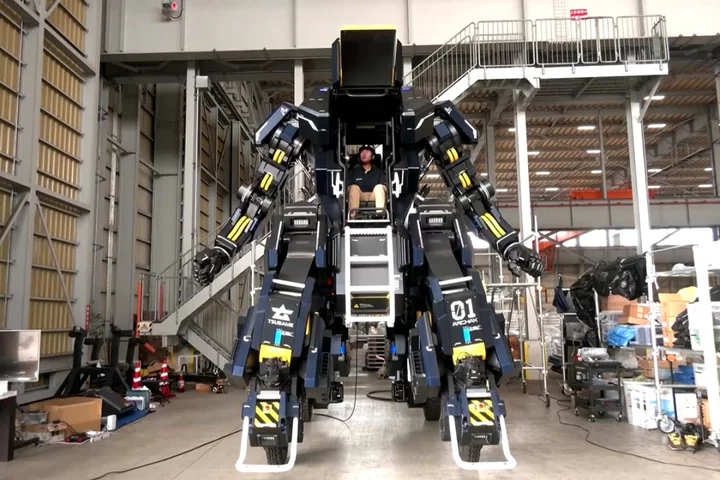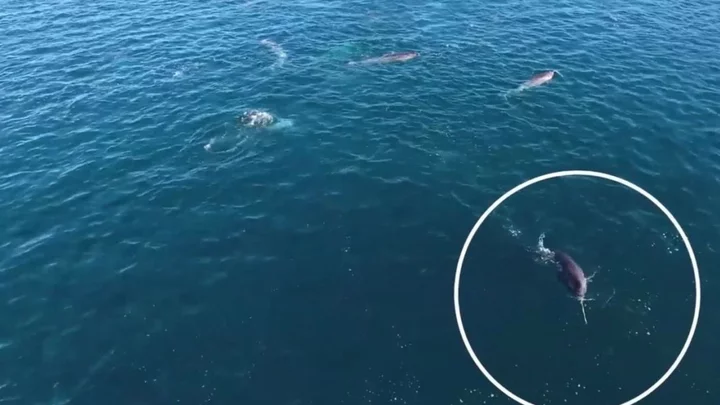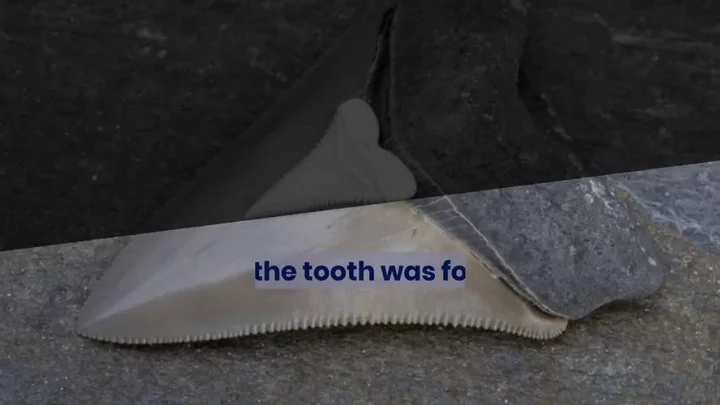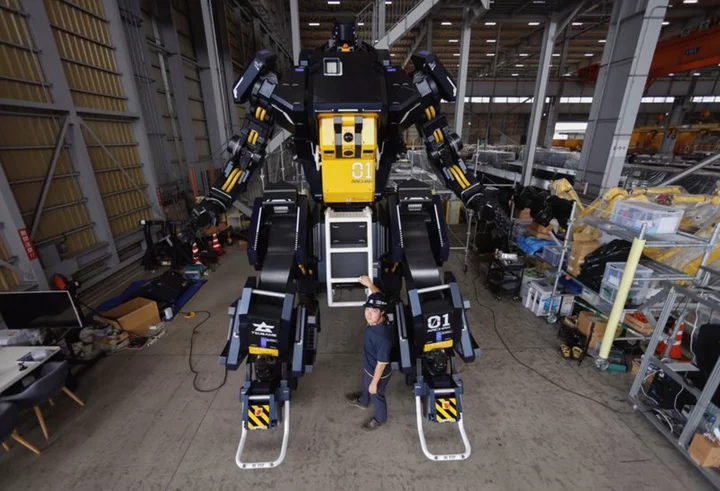
Elon Musk to live stream himself gaming on X in ‘everything app’ bid
Elon Musk has said he will live stream himself playing video games on X on Monday night as part of his goal of transforming the social media platform into an “everything app”. The tech billionaire previously tried to launch a gaming stream last week but ran into technical issues. “Tested the X video game streamer last night,” he posted on X on Monday. “It works!” The SpaceX and Tesla boss added that he would “try to complete a Tier 100 Nightmare dungeon” on Tuesday night during a live stream on X. Since taking over Twitter in October 2022, and renaming it to X in April 2023, Mr Musk has repeatedly stated his ambition to transform the social media platform into an “everything app”, starting by taking on streaming giants Twitch and YouTube. Similar to China’s WeChat, the app could eventually incorporate other functions and services like making payments, booking taxis or ordering food. Mr Musk has already secured money-transmitting licences in at least three US states, and has a history of building online payments platforms after co-founding PayPal. X chief executive Linda Yaccarino, who Mr Musk hired in June, laid out what this new version of the app might look like in a series of posts after joining the company. “X is the future state of unlimited interactivity – centred in audio, video, messaging, payments/banking – creating a global marketplace for ideas, goods, services, and opportunities. Powered by AI, X will connect us all in ways we’re just beginning to imagine,” she wrote. “For years, fans and critics alike have pushed Twitter to dream bigger, to innovate faster, and to fulfil our great potential. X will do that and more. We’ve already started to see X take shape over the past 8 months through our rapid feature launches, but we’re just getting started.” Before Mr Musk took over, Twitter had a video streaming feature called Periscope that was shut down in March 2021 due to declining usage. Mr Musk briefly tested the dormant feature in May 2023, though users dubbed him “8-bit Elon” due to the low quality resolution of the broadcast. Read More Elon Musk and the one trillion-dollar algorithm that explains everything he does Musk confirms he is cutting election integrity staff from X/Twitter ahead of 2024 Reddit will start paying people to post Tesla robot shown practising yoga
2023-10-02 20:59

Japan startup unveils 15-foot robot suit for space exploration
Engineers in Japan have created a 3.5-ton robot suit that resembles a character from a hugely popular animation series, which they hope to use for space exploration and in emergency situations. Tokyo-based start-up Tsubame Industries developed the 4.5-metre-tall (14.8-feet), four-wheeled Archax robot that looks like “Mobile Suit Gundam” from the 1970s Japanese show of the same name. Named after the avian dinosaur archaeopteryx, the $3 million (£2.5m) robot has cockpit monitors that receive images from cameras hooked up to the exterior so that the pilot can manoeuvre the arms and hands with joysticks from inside its torso. The robot, which will be unveiled at the Japan Mobility Show later this month, has two modes: the upright ‘robot mode’ and a ‘vehicle mode’ in which it can travel up to 10 km (6 miles) per hour. “Japan is very good at animation, games, robots and automobiles so I thought it would be great if I could create a product that compressed all these elements into one,” said Ryo Yoshida, the 25-year-old chief executive of Tsubame Industries. “I wanted to create something that says, ‘This is Japan’.” Mr Yoshida plans to build and sell five of the machines for the well-heeled robot fan, but hopes the robot could one day be used for disaster relief or in the space industry. Mr Yoshida became interested in manufacturing at an early age, learning how to weld at his grandfather’s ironworks and then going on to found a company that produces myoelectric prosthetic hands. He said he is eager to keep Japan’s competitive edge in manufacturing alive. “I hope to learn from previous generations and carry on the tradition,” he said. Tsubame Industries is one of several startups working on robotic exoskeletons, with applications ranging from assisting delivery workers with heavy loads, to military “super soldier” suits. The US military has already unveiled several exoskeleton prototypes, with one such device claiming to offer Marines the strength and ability of up to 10 troops. “The ultimate goal is to provide troops with an edge by boosting their capabilities and dramatically improving safety and productivity in a variety of logistics applications,” the company behind it, Sarcos Robotics, said in 2020. Additional reporting from agencies. Read More MIT invents self-replicating AI robots TikTok finds and shuts down secret operation to stir up conflict in Ireland Apple blames Instagram for overheating iPhones Royal website subject to ‘denial of service attack’, royal source says
2023-10-02 19:59

Groundbreaking footage shows how hammerhead sharks get their hammers
Hammerhead sharks are named that for a fairly obvious reason, but now groundbreaking footage has emerged which shows exactly how their unique head shape occurs. The strange-looking hammerhead shark has a very broad nose and spaced-out eyes that lend to its name and make it one of the most bizarre-looking sharks out there. Scientists studying the creature have until now had no idea how their hammers form, but now researchers have gotten a glimpse thanks to new footage. The species’ embryonic development is notoriously hard to study as they don’t lay eggs, so experts instead have been helped by the bonnethead sharks (Sphyrna tiburo), the smallest hammerhead species which is commonly found in estuaries and waters in the Gulf of Mexico and the Western North Atlantic Ocean. In a study published in Developmental Dynamics, researchers looked at embryos that had been preserved from bonnetheads that had been caught in previous studies to ensure that no additional sharks were affected. They studied embryos of the sharks at different stages of their development and witnessed as the shark's head started to form its unique shape. Hammerhead Transformation www.youtube.com The team found that the bonnetheads develop their head early on in their development, but the hammer doesn’t begin to form until around halfway through their gestation when the cartilage that forms the hammer begins to expand from the nasal area. The lead author, Steven Byrum, explained: “It’s the perfect qualities of the bonnethead that allowed us [to] do it with this species. “This was a unique opportunity we may not be able to get for very much longer with bonnetheads and may not be able to get in any other species of hammerhead.”
2023-10-02 19:54

There's a sinister reason why you never see narwhals in aquariums
Narwhals are among the most elusive creatures in the ocean, with their long, spiralling tusks giving them an almost mythological quality. And whilst many people would pay good money to see these unicorns of the sea in the flesh, they are notably absent from the world’s aquariums. The reason for this is both dark and mysterious, since there have only been two attempts to keep the toothed whales in captivity. Both of these ended in tragedy and the general acceptance that narwhals simply don’t belong in our sealife centres. The legendary porpoises, which are related to belugas and orcas, are found in Arctic coastal waters and rivers. They have two teeth and, in males, the more prominent of these grows into the swordlike tusk which can be up to 10 feet long, according to National Geographic. Back in 1969, Coney Island’s New York Aquarium becoming the first-ever centre to put a narwhal on display. According to IFL Science, the aquarium became home to a young calf called Umiak, whose name referred to the canoe used to hunt the species in the High Arctic. It was captured by members of the Inuit community who said that it followed their canoe back to camp after they killed its mother for meat. Umiak was put in a tank alongside a female “white whale” (most likely a beluga), who acted as its stepmother. And although staff reportedly fed vast quantities of milk mixed with chopped clams to keep it happy, they weren’t able to keep it healthy. Less than a year after Umiak arrived at the centre, the orphaned narwhal died of pneumonia, as reported by The New York Times at the time. Still, the animal’s swift and tragic demise didn’t stop Canada’s Vancouver Aquarium from attempting the same feat in 1970. The aquarium had been gearing up to host a narwhal since 1968, when its director, Murray Newman, hoped that bringing narwhals to the city could generate interest in the species and help with its conservation, IFL Science reports. After two unsuccessful attempts to capture one of the whales themselves, Newman and his team were forced to buy a young male from a community of Inuit hunters based in Grise Fiord on Canada’s Ellesmere Island. The animal was reportedly called Keela Luguk – a phonetic spelling of the word “qilalugaq”, which means “narwhal” in some Inuktitut dialects. Within a week of Keela Luguk’s arrival at Vancouver Aquarium in August 1970, the centre had caught two female narwhals and three calves, which were then added to his tank. However, in less than a month, the three calves had died. And by November, the two females were also gone. As public outrage mounted, the mayor of Vancouver himself called for Keela Luguk to be returned to the wild. But Newman would not succumb to their pressure and, eventually, on 26 December that same year, the young whale was reported to have died too. It’s not known exactly why the narwhals fared so dismally in captivity, particularly given that the species’s closest relative, the beluga, can survive a number of years, or even decades, in aquarium facilities. However, the porpoises are known to be exceptionally sensitive animals, with studies finding that they are so affected by human-made noises that even the sound of a ship sailing near their habitat is enough to radically impact their behaviour. Fortunately, aquariums seem to have got the memo, and narwhals have largely been left to continue their lives as fabled enigmas of the sea. Sign up for our free Indy100 weekly newsletter Have your say in our news democracy. Click the upvote icon at the top of the page to help raise this article through the indy100 rankings.
2023-10-02 19:29

Divers discover Megalodon teeth in flooded cave in Mexico
Divers in Mexico have discovered Megalodon teeth in a flooded inland cave and the findings have confirmed scientific beliefs. Megalodons were absolutely gigantic prehistoric sharks that reached sizes of up to 50 feet long. They dominated the oceans before going extinct around 3.6 million years ago. Scientists are interested in studying fossils of the huge sea creature, with the animal's teeth proving the most abundant type of fossil to be found today. Teeth fossils were found in Mexico by speleologist (cave specialist) and photographer Kay Nicte Vilchis Zapata and fellow speleologist Erick Sosa Rodriguez while diving in a newly discovered sinkhole in Cholul in 2019. The cenote is 400 meters long and 28 meters deep and located inside were fifteen teeth fossils from various shark species. They also discovered human remains and a vertebrae fossil that potentially belongs to an ancient species. A total of 13 of the 15 teeth fossils belonged to three different species of shark – one being the megalodon (Carcharocles megalodon), while the other two species were the mackerel shark (Isurus oxyrinchus) and the sawshark (Pristiophoridae). Zapata told local media at the time: “We were looking at the wall and suddenly I saw a little something, I went closer and I saw that it was a tooth, that was the first and apparently it belonged to a sawshark.” Experts believe the geological timescale of the megalodon teeth lies anywhere between 2.5 million to 5 million years old. Speleologist Sosa Rodriguez said: “It is just proof of what scientists have already studied and written about; what kind of wildlife lived here millions of years ago when this was part of the sea.” Scientists have suggested that the megalodon’s warm body temperature may have been the reason for its extinction. There is some thought that the megalodon was able to maintain a body temperature around 7 degrees centigrade warmer than the water around it, but ultimately this may have been its downfall. Randy Flores, a UCLA doctoral student and fellow of the Centre for Diverse Leadership in Science, explained: “Maintaining an energy level that would allow for megalodon’s elevated body temperature would require a voracious appetite that may not have been sustainable in a time of changing marine ecosystem balances when it may have even had to compete against newcomers such as the great white shark.” Sign up to our free Indy100 weekly newsletter Have your say in our news democracy. Click the upvote icon at the top of the page to help raise this article through the indy100 rankings.
2023-10-02 17:54

Apple blames Instagram for overheating iPhones
Apple has blamed Instagram and other popular apps for an overheating issue with the iPhone 15. The US tech giant said a software bug tied to the Meta-owned app was among the reasons for users reporting that its latest range of smartphones, unveiled last month, become “too hot to touch” while performing certain tasks. The company is working on an update to its latest iOS 17 operating system, which serves as the software for the iPhone 15, iPhone 15 Plus, iPhone 15 Pro and iPhone 15 Pro Max. Meta has acknowledged the issue, which some users have dubbed “heatgate”, and modified its Instagram app in an effort to prevent it from heating up the device. Other apps blamed for the problem, including Uber and the video game Asphalt 9, are yet to roll out updates, according to Apple. There is also no timeline for when Apple’s own software fix would be issued but the firm said no safety issues should prevent iPhone 15 owners from using their devices while awaiting the update. “We have identified a few conditions which can cause iPhones to run warmer than expected,” Apple said in a short statement. It’s not unusual for new iPhones to get uncomfortably warm during the first few days of use or when they are being restored with backup information stored in the cloud – issues that Apple already flags for users. The devices also can get hot when using apps such as video games and augmented reality technology that require a lot of processing power, but the heating issues with the iPhone 15 models have gone beyond those typical situations. In its acknowledgement, Apple stressed that the trouble isn’t related to the new titanium casing that houses the high-end iPhone 15 Pro and iPhone 15 Pro Max instead of the stainless steel used on older smartphones. Apple also dismissed speculation that the overheating problem in the new models might be tied to a shift from its proprietary Lightning charging cable to the more widely used USB-C port that allowed it to comply with a mandate issued by European regulators. Although Apple expressed confidence that the overheating issue can be quickly fixed with the upcoming software updates, the problem still could dampen sales of its marquee product at a time when the company has faced three consecutive quarters of year-over-year declines in overall sales. The downturn has affected iPhone sales, which fell by a combined 4 per cent in the nine months covered by Apple’s past three fiscal quarters compared with a year earlier. Apple is trying to boost its sales in part by raising the starting price for its top-of-the-line iPhone 15 Pro Max to $1,200, an increase of $100, or 9 per cent, from last year’s flagship model. In its acknowledgement of the iPhone 15 overheating issue, Apple said the planned software update would not impact the phone’s performance, which analysts had warned is a possibility. Additional reporting from agencies Read More Tim Cook interview: Apple boss talks trillion-dollar transformation and ushering in new era of computing
2023-10-02 16:22

Dutch regulator rejects Apple’s objections against fines
AMSTERDAM Dutch competition watchdog ACM on Monday said it had rejected objections by Apple against fines of 50
2023-10-02 15:56

Japan startup develops 'Gundam'-like robot with $3 million price tag
By Satoshi Sugiyama and Chris Gallagher YOKOHAMA, Japan Tokyo-based start-up Tsubame Industries has developed a 4.5-metre-tall (14.8-feet), four-wheeled
2023-10-02 10:28

Royal website subject to ‘denial of service attack’, royal source says
The royal website was subject to a “denial of service attack”, a royal source has said. It was down for an hour-and-a-half on Sunday morning from 10am. A denial of service attack means the site was bombarded by traffic, which caused it to stop working, the source said. It is not the same as hacking, in which whoever is responsible actually gets into a website and the site is compromised. Neither the content nor the systems of the royal website were accessed on Sunday. It is currently unknown who is responsible for the cyber attack, the source said. The site is now up and running as usual. Read More Charity boss speaks out over ‘traumatic’ encounter with royal aide Ukraine war’s heaviest fight rages in east - follow live
2023-10-01 21:47

Scientists now say finding alien life in the universe is 'only a matter of time'
Scientists are optimistic about the possibility of finding life on other planets. Nasa's James Webb Space Telescope (JWST) found a possible sign of a gas that, on Earth, is produced by simple marine organisms. It was detected this month in the atmosphere of a planet named K2-18b, which is 120 light years away. The planet is in what astronomers call ''the Goldilocks zone' - the right distance away from its star for the surface temperature to be neither too hot nor too cold, but just right for there to be liquid water, which is essential to support life. The team expects to know in a year's time whether the hints are confirmed or have gone away. "We live in an infinite Universe, with infinite stars and planets. And it's been obvious to many of us that we can't be the only intelligent life out there," Prof Catherine Heymans, Scotland's Astronomer Royal told the BBC. "We now have the technology and the capability to answer the question of whether we are alone in the cosmos." Prof Nikku Madhusudhan of the Institute of Astronomy at Cambridge University, who led the study, told the BBC that if the hints are confirmed "it would radically change the way we think about the search for life". "If we find signs of life on the very first planet we study, it will raise the possibility that life is common in the Universe." He predicted that within five years there will be "a major transformation" in our understanding of life in the Universe. If his team don't find life signs on K2-18b, they have 10 more Goldilocks planets on their list to study - and possibly many more after that. Even finding nothing would "provide important insights into the possibility of life on such planets", he said. Meanwhile there are other separate projects all looking for signs of life in the universe. Pretty exciting. Sign up to our free Indy100 weekly newsletter Have your say in our news democracy. Click the upvote icon at the top of the page to help raise this article through the indy100 rankings.
2023-09-30 23:28

Atari 2600+ sees its future in retro gaming
The Atari home video game system took the late1970s and early 1980s by storm, complete with faux wood paneling and a classic joystick with a big red button. Rival systems eventually surpassed the video-game pioneer but its iconic status, and fans, remained.
2023-09-30 20:23

Binance to sell Russia business for undisclosed amount
(Reuters) -Cryptocurrency exchange Binance said on Wednesday it will sell its Russia business to newly-launched exchange CommEX, becoming the latest
2023-09-30 05:24
